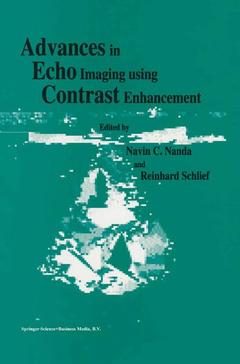Advances in Echo Imaging Using Contrast Enhancement, Softcover reprint of the original 1st ed. 1993
Langue : Anglais
Coordonnateurs : Nanda N.C., Schlief R.

This book will familiarize the reader with recent advances in echo imaging technology with special emphasis on echo enhancing agents. Several important strides have been made in this field during the past few years, especially in the contrast enhancement of conventional and color Doppler images. The book begins with chapters on the history of contrast echocardiography, the principles of contrast echo and descriptions of new contrast agents capable of transpulmonary passage following intravenous injection. Safety issues in contrast echocardiography are also discussed. The second section of the book deals with clinical uses of echo contrast agents. Their usefulness in the identification of cardiac structures and assessment of pathological lesions using both transthoracic and transesophageal echocardiography are fully discussed. Technical and practical considerations in the use of various contrast agents are also described. The use of contrast echo in the identification of cardiac sources of embolism as well as possible mechanisms and clinical significance of spontaneous contrast echoes are also covered. Six chapters fully discuss the basics of contrast enhancement of conventional and color Doppler images and its clinical utility in the noninvasive assessment of pulmonary artery pressure, regurgitant and stenotic lesions and in the delineation of coronary arteries. Another chapter describes the non-cardiac applications of the echo contrast enhancement technique. The final section of the book investigates the role of echo contrast enhancement in quantitative cardiovascular analysis.
One: History, basics and safety of contrast agents.- 1. Contrast-echocardiography — a historical perspective.- 2. Principles of echo contrast.- 3. Conventional echo-contrast agents. Hand preparation, sonication, properties.- 4. Albumin spheres as contrast agents.- 5. Saccharide based contrast agents.- 6. Echocontrast enhancers — how safe are they?.- 7. Gas bubble dynamics in acoustic fields and their biological consequences.- Two: Clinical uses of contrast agents.- 8. Clinical uses of contrast agents — practical considerations.- 9. Structure identification by transthoracic contrast echocardiography.- 10. Identification of right sided structures by contrast transesophageal echocardiography.- 11. Left ventricular contrast echocardiography — echoventriculography.- 12. Diagnosis of patent foramen ovale by transesophageal and transthoracic echocardiography.- 13. Spontaneous echographic contrast — etiology and clinical implications.- 14. Contrast enhanced Doppler in the noninvasive measurement of pulmonary artery pressure.- 15. Contrast enhanced Doppler in the assessment of aortic stenosis.- 16. Contrast enhanced color Doppler — basics and potential clinical value.- 17. Contrast enhanced color Doppler in the assessment of mitral regurgitation.- 18. Transesophageal echo-Doppler studies of coronary arteries — identification, assessment of flow reserve and value of contrast enhancement.- 19. Transesophageal echocardiographic assessment of coronary arteries using echo-contrast enhancement.- 20. Diagnostic value of contrast enhancement in vascular Doppler ultrasound.- Three: Future perspectives.- 21. Quantitative contrast Doppler intensitometry.- 22. Role of echo-contrast in quantitative analysis.- 23. Potential applications of color-Doppler imaging of the myocardiumin assessing contractility and perfusion.- 24. Myocardial imaging by color-Doppler coded velocity mapping — from regional contraction to tissue characterization?.
Date de parution : 10-2013
Ouvrage de 405 p.
15.5x23.5 cm
Thèmes d’Advances in Echo Imaging Using Contrast Enhancement :
Mots-clés :
cardiovascular; contrast agent; diagnosis; echocardiography; embolism; imaging; ultrasound; Ultrasonography
© 2024 LAVOISIER S.A.S.



